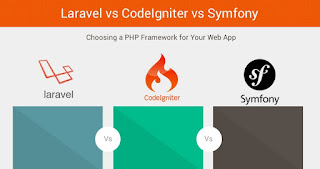Top 5 Famous Web Development Frameworks In 2018

A customer not just requires a website or a mobile app they also look for the latest trends in the market and what their competitors are going for. It is not easy to satisfy them as a basic online presence is just not sufficient. Pacing up with latest technological innovations is equally important. Selecting a web development platform/framework often becomes a scary affair especially when your customer is unsure about its features or you are diffident about its functionalities and effects that it can bring up in the developed application.
Here is a list of top 5 development frameworks with cutting-edge technologies that will help to save time and cost:
1) AngularJS
There can be some interesting and irresistible advantages of using AngularJS for all your upcoming development projects. After having used couple of JavaScript MVC libraries and with a generous experience of having worked with Jquery there is a silver lining which attracts us towards it.
Back in the day, you clambered with Jquery and simultaneous unstructured JavaScript code, it was all over the place but was not easy to read. With the added structure, templating, two-way data binding, AngularJS will bring more sense to JavaScript applications. It works wonders for single page applications, where this library will provide all the required things and you just have to ensure the correct use of the library.
2) Laravel
Laravel reposes PHP codes. Since its release 6 years back, it has taken the web world by storm. Latest is version 5.5, released in August 2017. Support for Model View Controller (MVC) makes it compatible with many other built functions to select from better development architecture.
From handling packages to composer dependency tools Laravel has got so much to offer. It integrates light weigh blade templating engine. Above all, Laravel authentication library makes it highly adorable and safe environment to work.
3) ReactJS
It provides a lot of value to the right audience. Developing in ReactJS is not only going to be easy, it is also going to be worth it. Although it is not a full blown network solution, however, has all the capabilities of JavaScript library. Reusing existing code and virtual DOM makes performance clear and an overall rich user experience. Rich in design and debugging tools, ReactJS can be fun to use in a real development environment. It gels up well with JSX (a correct mix of HTML and JavaScript) and simultaneously prevents injection attacks. Does JSX violate with ReactJS? Well, it may or may not. It’s a matter of separation of concerns.
4) Node.js
JavaScript is the king of all client-side programming languages and forms the core for startups as well as established enterprises. It has quickly become a major tool for backend as well as cross-platform mobile app development. It wins in case of speed, scalability, support and learning curve and is undoubtedly preferred by most of the startups. This works equally well for Minimal Viable Products (MVPs) as well as for heavy CPU applications. It uses is appreciable for even driven web applications which require a dedicated connection from the server to user and back. Additionally, it fills up the client-server gap by re-using the entire available gap.
5) Ruby on Rails

Comes with ready-made plugins, developers do not have to waste time on boiler-plate codes. It encourages test driven and behavior development and with the test suite that encourages many useful testing features including expectation syntax, mocking and test benchmarking. No coding from scratch is actually required as it allows you to add features subsequently. Further, it can scale up to entertain all the users that come on its app/website. Adding one more feather to the cap, it is free to be used and runs on Linux platform.
Know more : http://www.wamasoftware.com

Comments
Post a Comment